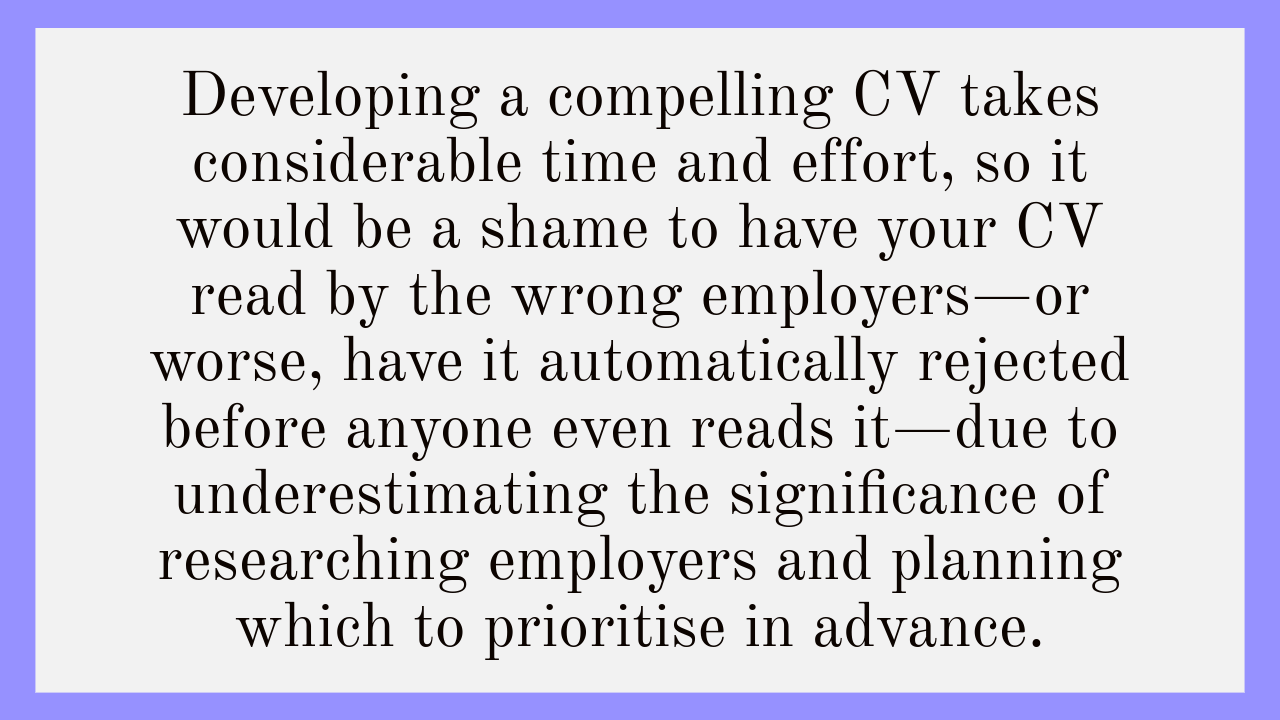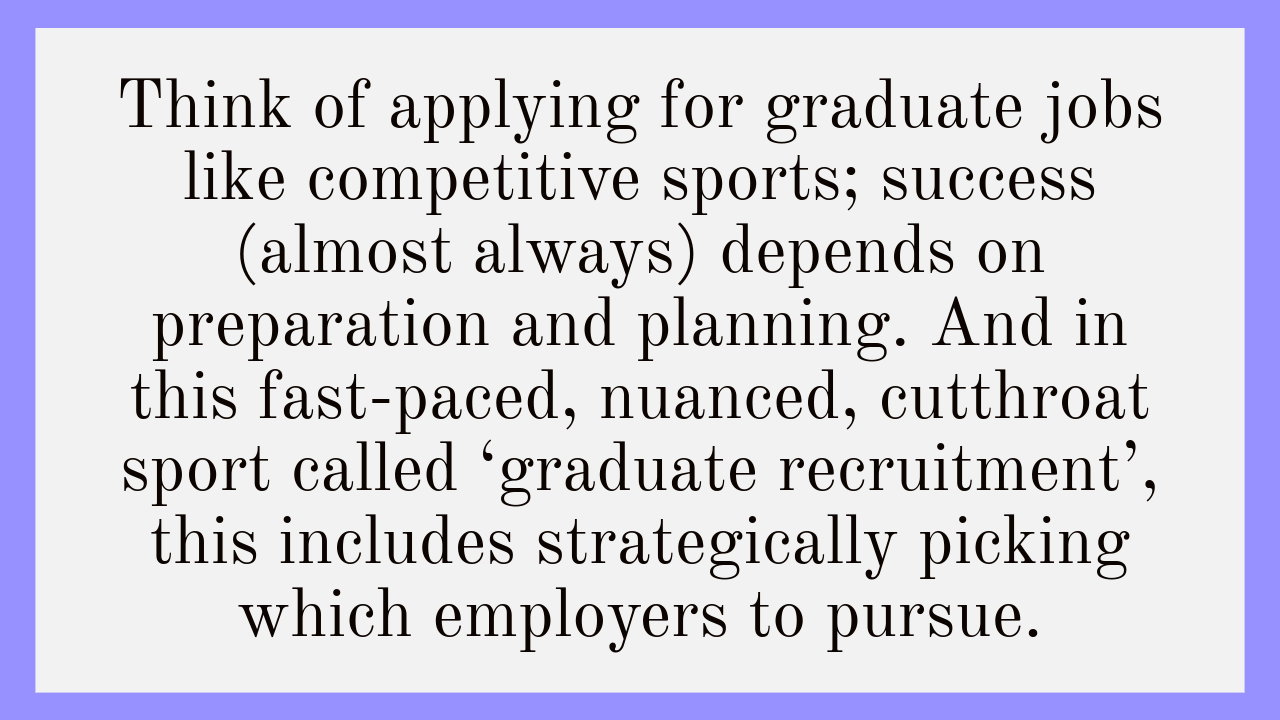This is Why You Need to Be Strategic About the Employers You Target
A 10-step guide to creating a strategic list of employers to target for graduate jobs
This post introduces a 10-step guide to creating a strategic list of employers to target for graduate jobs, i.e., insight programs, internships and full-time graduate roles. With hundreds of graduate employers in the market, it's crucial to avoid the overwhelming and highly inefficient approach of trying to apply to all of them—or even just a quarter of them. Instead, you should thoughtfully select a much smaller subset of employers to focus on. This post will share strategies to help you choose which employers to target to increase the chances of your CV successfully passing the rigorous, fast-paced, competitive CV screening round conducted by top graduate employers.
Remember that company that rejected your job application despite your strong CV? This newsletter will show you what probably happened.
Welcome to Keep, Ding, Ghost! A (roughly) weekly newsletter and podcast that provides feedback to graduate job applicants through FREE CV reviews.
Founder/Author: L. C. Serrão
Click here for FAQs. Click here for the Master Index.
Hey, guys! If I were asked to list the ‘best practices’ of applying for graduate jobs, most of the list would probably relate to the central topic of today’s post: selecting which employers to target.
Why is this so important, you ask? Well, ‘important’ is an understatement. Critical, imperative, and essential might better convey the necessity of having a target list.
If you want to discover a reliable approach to avoid these pitfalls and increase your chances of having your CV considered by employers who are best aligned with your career goals and who also consider you a target, this post is for you!
There are hundreds of graduate employers, and attempting to apply to each one—or even just a quarter of them—would be overwhelming and inefficient (to say the least). Don’t let those (insane) ‘I applied to 100+ universities and got millions in scholarships’ stories mislead you. Utilise your time and efforts wisely because when it comes to applying for graduate jobs (i.e., insight programs, internships and full-time graduate roles), as the meme goes: ‘the pressure is very much’, lol. So, focus on a small subset of employers. Please.
If you don’t know how to select which graduate employers to have in your subset, don't worry. This post will guide you through the process.
Since the ultimate goal is to enhance your likelihood of successfully passing the rigorous, fast-paced, competitive CV screening round conducted by top graduate employers, this post will focus on strategies for selecting the right set of employers—for you. Everyone’s subset, i.e., target list, should reflect their individuality as a job candidate.
When I was younger and in the process of applying for internships as an Imperial undergrad, I rarely knew what I was doing. But the one thing I did exceptionally well (although I didn’t realise at the time just how effective it would be) was to select a subset of employers to target and then focus on learning as much as possible about each one before finalising my CV. This strategic approach gave me a sense of control over my recruitment journey and boosted my confidence in the application process. As most of you would have read in this newsletter’s FAQs post, I ended up interning at Goldman Sachs and Morgan Stanley.
There are applicants that come across a role they find interesting and apply on the spot. Little to no time is spent learning about the employer or the role beforehand beyond maybe skimming the company’s ‘About’ page. And this lack of research and preparedness will show not only through your CV (yes, there are tell-tale signs) but also in who you target—or, more importantly, who you fail to target—as an employer.
Below are some examples of why carefully selecting which graduate employers to target is an effective strategy:
Some graduate employers are actively looking for you. Well, you = students and alums from your university or grad school, but you get the point; they consider you a target. Knowing who they are = knowing who would most likely prioritise your application.
Some graduate employers only recruit a handful of students and recent graduates each year, while others recruit 1,000 each year. Are you applying to both types, or are your applications monopolised by those with only a few available spots?
Many graduate employers host recruitment events. Have you researched which ones? Given event spots are usually limited, attending is a strategic way to introduce yourself to the company. You’d also be able to take advantage of the networking opportunities. This could be your chance to impress an employee you meet at an event, who could proceed by flagging your name to the recruitment team so that when you apply, your CV is fast-tracked to the ‘advance to the next round of the application process’ pile.
The above are just some of the reasons why you shouldn’t underestimate the importance of being strategic about the employers you target for graduate jobs. And, lucky for you, I can make the task of selecting which employers to target more manageable (and hopefully, more interesting)!
Cue: the 10-step guide to creating a strategic list of employers to target for graduate jobs!
Each step will provide tips and resources to help you decide which employers most deserve your blood, sweat and tears (not literally, I hope, lol).
Hence, the ultimate goal of the 10-step guide is to help you create your list of target graduate employers. We’ll work on this task together, focusing on one step per week. At the end of each step, you’ll be able to use the resources or knowledge gained immediately, whether to apply for jobs now or to prepare for the jobs you will apply for from September 1st, when the new graduate recruitment year starts.
The weekly schedule for each step is outlined shortly after the poll below. If you’re new to this newsletter, make sure you also check out the pinned Frequently Asked Questions post, which includes additional fun polls.
10-Step Guide: Schedule
Below is the expected publication schedule for the posts in the 10-step guide.
Please note this schedule is subject to change. Any changes will be communicated via an update to this post and will take effect immediately.
📆 Published: Step 1 (List of Employers)
If you’re struggling to identify who the graduate employers are, this first step will be incredibly helpful. I will provide you with a list of 150+ top graduate employers, which will serve as a base for creating a strategic list of employers to target. I will also include data on the typical number of spots these employers make available each year for students and recent graduates.
This post has now been published. Please click here to view the post, and click here and here to read the follow-up posts related to this first step.
📆 Week beginning TBC: Step 2 (Target Schools)
Graduate employers often have preferred ‘target schools’ for recruitment. If you are a student or recent graduate of one of these target schools (i.e., universities or grad schools), it’s a significant advantage. If not, that employer might be out of your league unless you have something else they consider special. Step 2 will dive into which graduate employers target which schools, using the list from Step 1, and how this should influence who you add to your list of target employers. For example, we will explore whether your shortlist should still include employers that don’t consider your university or grad school a target school (spoiler alert: yes, it definitely should, but how many is probably a better question). Also, if you’re anything like me, I am sure you'll have fun investigating which graduate employers have a preference for your university/grad school and which have a preference for your rival universities/grad schools, hehe.
📆 Week beginning TBC: Step 3 (Exit Options)
If I could only give you one piece of advice about shortlisting employers, it would be to carefully consider ‘exit options’—the types and quality of opportunities that would most likely be available to you after working for a specific employer. To this day, exit options dictate my professional choices. In this second step of the 10-step guide, we’ll explore how to use exit options as a key filtering consideration to create a strategic list of employers to target for graduate jobs using specific examples from the 150+ top graduate employers list provided in the first step.
📆 Week beginning TBC: Step 4 (Networking)
It’s not just the concept of ‘target schools’ (Step 2) that you should use to inform your shortlist of target employers. You should also use your network—and this is particularly important if you don’t go to a target school. Hence, in Step 4, I’ll guide you on how to find or create a network, connect with it, and use it to decide which employers to target.
📆 Week beginning TBC: Step 5 (Entry Requirements: Year of Study)
By this step, we'll have filtered the list of graduate employers provided in the first step by exit options, target schools, and network. However, none of these will matter if you don’t meet the employer’s minimum entry requirements. This step (5) will focus on the ‘year of study’ eligibility requirements. Using the list of 150+ top graduate employers from Step 1, I will show you which employers offer which type of graduate jobs (i.e., insight programs*, internships**, full-time graduate roles***) and what year of study or graduation year would make you eligible to apply.
*Insight programs are typically for students in their first year of a three-year degree course or second year of a four-year degree course;
**Internships are typically for students in their penultimate year of a degree course) and;
***Full-time graduate roles are typically for students in their final year of a degree course and recent graduates.
📆 Week beginning TBC: Step 6 (Entry Requirements: Location)
Step 6 addresses the ‘location’ entry requirement—which is usually just another way of saying ‘visa/nationality/citizenship’ preferences (yes—emphasis on the word ‘preference’ as opposed to ‘requirement’). We’ll use the graduate job list from Step 5 to identify which locations are recruiting and how to make strategic decisions based on location options.
📆 Week beginning TBC: Step 7 (Entry Requirements: Academics)
In Step 7, we’ll examine the ‘academic’ entry requirement, i.e., minimum grades and subjects.
📆 Week beginning TBC: Step 8 (Salaries)
With the key entry requirements out of the way, in Step 8, we will move on to another critical factor: pay. I’ll provide data on graduate salaries to help you refine your list of employers to target for graduate jobs based on compensation.
📆 Week beginning TBC: Step 9 (Deadlines)
The timing of your applications can give you a competitive edge. In Step 9, I’ll show you how to use deadlines strategically. One rule of thumb when applying for graduate jobs that I insist on sharing now is that you should rarely trust a deadline; as the saying goes, ‘early is on time, and on time is late.’
📆 Week beginning TBC: Step 10 (The Result)
The final step involves evaluating your shortlist to ensure it’s well-rounded and balanced across industries and types of employers. This will also include ensuring your graduate employer target list has a sensible number of ‘insurance choices’. Within the context of this 10-step guide, the term ‘insurance choices’—which my UK subscribers will recognise from the Universities and Colleges Admissions Service (UCAS) process—refers to graduate employers that you can use as backup options if you do not secure offers from your top choices. By the end of this step, you should have a strategic set of employers to target for insight program, internship and/or full-time graduate role applications. I'll also provide you with my shortlist of target graduate employers from when I first applied for graduate jobs and what my target list would look like if I were to apply today.
You’ve reached the end of this post—thanks for reading! I appreciate your time and interest!
Read/Learn More:
🔗Here’s the criteria I’ll use to review your CV
🔗What defines a CV as being in good ‘form’?
🔗The top 3 reasons CVs are rejected
🔗Keep, Ding, Ghost CV Review Sessions
💬 Question Time:
Which step from the 10-step guide are you most excited about/did you find the most insightful or enjoyable? Let me know in the comment section. I would love to hear from you!
One More Thing:
If you enjoy this newsletter/podcast, there are several ways to let me know: 'like' this post, leave a comment, share this post, restack your favourite section of it (or the entire post), or become a premium subscriber (which you could potentially upgrade to for FREE).
✨Additionally, if you’d like to win a 1:1 virtual session with me to discuss recruitment-related topics such as your CV, cover letter, or interview, click here!









